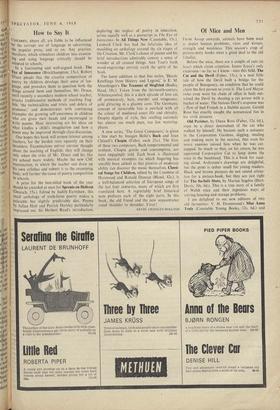How to Say It
CHILDREN, above all, are liable to be influenced by the corrupt use of language in advertising, the popular press, and so on. Any practice, therefore, which stimulates children into examin- ing and using language critically should be adopted in schools.
In a fascinating and well-argued book, The Eye of Innocence (Brockhampton, 15s.), Robert Druce pleads that the creative composition of Poetry by children develops their sense of lan- guage, and provokes them to question both the things around them and themselves. Mr. Druce, until recently a secondary modern school teacher, attacks traditionalist methods of teaching Eng- lish, 'the technicalities and trivia and debris of grammar,' and demonstrates with convincing examples the growing self-awareness in children Who are given their heads and encouraged to write poems. Most interesting are his ideas on what kindles a child's imagination and how a Poem may be improved through class-discussion.
One hopes this book will arouse interest among teachers, for the burden rests squarely on their shoulders. Examinations mirror current thought about the teaching of English; they will change Only when the cries of Mr. Druce and his like are echoed more widely. Maybe the new CSE examination, in which the teacher can draw up his own syllabus and submit it to the examining !)0(111, will further the cause of poetry composition In schools.
A prize for the best-titled book of the year should be awarded at once for Sprouts on Helicon (Deutsch, 15s.). Edited by Judith Earnshaw, this small anthology of sixth-form poetry makes a Palatable but slightly predictable diet. Poems by Julian Holt and Patrick Horsley particularly impressed me. Sir Herbert Read's introduction,
deploring the neglect of poetry in education, serves equally well as a postscript to The Eye of Innocence. In All Things New (Constable, I5s.), Leonard Clark has had the felicitoits idea of moulding an anthology around the six stages of the Creation. Mr. Clark's choice of poems and his brief introductions admirably convey a sense of wonder at all created things. Ann Tout's fresh wood-engravings entirely catch the spirit of the book.
The latest addition to that fine series, 'Heroic Retellings from History and Legend,' is E. M. Almedingen's The Treasure of Siegfried (Bodley Head, 18s.). Taken from the thirteenth-century Nibelungenlied, this is a dark episode of love cut off prematurely, hate, murder and vengeance, gold glittering in a gloomy cave. The Germanic concept of inexorable fate is overlaid with all the colour of mediaeval court life and chivalry. Despite dignity of style, this retelling curiously has almost too much pace, too few watering- places.
A new series, `The Great Composers,' is given a fine start by Imogen Hoist's Bach and Joan Chissell's Chopin (Faber, each 21s.). The lives of these two composers, Bach temperamental and resilient, Chopin gentle and consumptive, are most engagingly told. Each book is illustrated with musical examples (to which fingering has sensibly been added) so that pianists-of moderate ability can discover the music themselves. Classi- cal Songs for Children, edited by the Countess of Harewood and Ronald Duncan (Blond, 42s.), is a well-balanced selection of European songs of the last foar centuries, many of which are first translated here. A regrettably brief historical note prefaces each of the eight parts. In this book, the old friend and the new acquaintance stand shoulder to shoulder. Vivid!
KEVIN CROSSLEY-HOLLAND


































 Previous page
Previous page